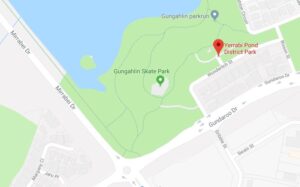This walk will start with a walk on the Southern/Eastern side of Yerrabi Pond with an extension (car pooled driving) to Gorman St in Nicholls to check out a pond further downstream on Ginninderra Creek. Meet at 8:30 on 21 February at Yerrabi Pond District Park off Wunderlich St – park in the first car park on the left.

Wed 21 February 2018 08:30am
Martin ButterfieldPost event report
25 Members gethered on the shores of Yerrabi Pond with the intention of heading to the Western end. Departure was slightly delayed by the appearance of 5 Superb Parrots but we began our shore patrol about 8:45.
Counting of Eurasian Coots began as soon as we could see water! Cutting to the chase, by the time we turned for home the total was up to 470. Bill Graham advised that at peak he had assessed 800 Coots here, but he agreed there were many less today.
On the shore we spotted a Red-rumped Parrot being fed by an adult female which counted as Feeding Young (which presumably maps to the COG DY category). A little further along some members were busy observing a young Pacific Koel. A few metres back from this a similar ruckus was audible, which was not surprising as there was a second Koel. Both attended by Red Wattlebirds. The breeding activity was completed by Magpie Lark and Australian Reed Warbler Feeding Young.
With a good array of other water birds and bush birds we recorded 41 species at this site https://ebird.org/view/checklist/S43050703. It would have been 42 had we spotted the Red-capped Robins recently reported from here but we didn’t.
So it was braving the foul traffic along Gundaroo Rd and on to Gungahlin Pond. Thanks to members cooperation (and the departure of a few observers for other duties) we had condensed to 6 cars which fitted nicely in the parking spots on Gorman Cr.
Again we started counting Coot as soon as we got in sight of the water, ending with an estimate of 350. Also 20 Black Swans, 20 Little Pied Cormorant and 30 Little Black Cormorant, one of which did a fly-by carrying a stick which was interpreted as Nest Building.
The main business here was the activity on the 3 small Islands in the middle of the pond. The most obvious were an estimated 80 Australian White Ibis of which several were ON (Occupied Nests). A few Straw-necked Ibis were hanging around in the trees and the addition of a flight of 19 gave a total of 23 for this species. The excitement of the day however was the Leader thinking that he saw a Royal Spoonbill on a nest containing two fluffballs. After quite a few minutes peering by everyone with a telescope or long lens I was confirmed that a pair of Royal Spoonbills were raising chicks in that nest. I think that is the third ACT breeding event for that species.
Allowing for other species seen we recorded 23 species for this site https://ebird.org/view/checklist/S43050708. Combining sites the total species for the day was 45.
